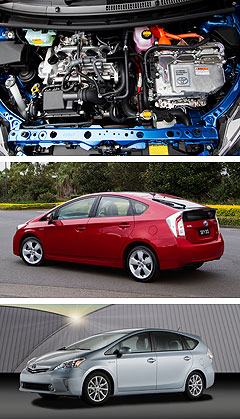New models - Toyota - Prius CToyota defends Prius C efficiencyPipped at the post: The new Toyota Prius C has failed to take the title of Australia's most fuel efficient car from a suite of European diesel hatchbacks. Next Prius to learn from Prius C hybrid system, despite it being no more efficient29 Mar 2012 TOYOTA has defended the efficiency of its all-new Prius C mini-hybrid, which fails to improve on the 3.9L/100km combined fuel consumption figure of the standard Prius despite being significantly smaller, lighter and less powerful. In fact, it describes the pint-size Prius C’s downsized Hybrid Synergy Drive system, which emits more CO2 on average than the larger Prius, as a ‘3.5-generation’ hybrid system that will provide valuable lessons for the fourth-generation Prius powertrain. Launched this week with a new Australian hybrid price benchmark of just $23,990, the Yaris-based Prius C measures just 3995mm long and has a kerb weight starting at 1120kg. The second member of Toyota’s expanding Prius family combines a 54kW/110Nm 1.5-litre Atkinson-cycle petrol engine with a 45kW/169Nm AC synchronous electric motor/generator powered by a 520-volt Nickel Metal Hydride battery to deliver a total output of 74kW. Yet it merely matches the 3.9L/100km combined-cycle fuel consumption of the 285kg heavier, half-metre-longer Prius, which is powered by a 73kW/142Nm 1.8-litre engine matched with a similarly bigger and more powerful electric motor to deliver a total system output of 100kW.  From top: Prius C hybrid powertrain, Prius hatch and Prius V. From top: Prius C hybrid powertrain, Prius hatch and Prius V.Indeed, the bigger Prius is still slightly ‘cleaner’ with an average CO2 emissions figure of 89g/km (versus 90g/km for the C). As such, the title of Australia’s most fuel-efficient new car continues to be jointly held by larger diesel-powered manuals in Volkswagen’s Golf BlueMotion, the Mini Cooper D, Audi A1 1.6 TDI and Volvo C30 DRIVe, all of which return 3.8L/100km but emit more CO2. Inexplicably, the C fails to better the Prius’ combined consumption figure despite achieving lower urban (3.7L/100km) and extra urban (highway: 3.8L/100km) figures. Toyota points out the C sets a new economy yardstick in city driving, where it is likely to spend most of its time, and blames the anomaly on the official ADR 81/02 laboratory test cycle - about 60 per cent of which is based on highway driving conditions, where hybrid technology is traditionally least effective. It also points to the difficulty in making the B-segment Prius C’s much shorter body as aerodynamic as the C-segment Prius. The Prius C has a drag coefficient of 0.30Cd, meaning it is far less slippery than the longer Prius (0.25Cd). But it makes no apologies for falling short of the fuel consumption standards set by the bigger European diesel hatches or Ford’s new Focus Econetic, which sets a new benchmark of just 3.4L/100km and is under consideration for Australian release. Toyota Australia’s corporate manager of product planning Greg Gardner said the Prius C’s higher than expected combined-cycle consumption figure was “due to atmospheric winds and the prevailing conditions”. “Prius is the flagship of the hybrid range, so it will always have a premium position in terms of its fuel economy and its leading edge technology. It will always set the benchmark.” Toyota Australia divisional manager Peter McGregor said: “Those figures that we’ve quoted regarding fuel efficiency are anything but disappointing. We are very proud of this product and its achievements and the contribution it will make to the environment in Australia.” Prius C chief engineer is Satoshi Ogiso, who was also involved in the development of all three generations of the regular Prius, said Toyota’s priority with the Prius C city-car was to make it as efficient as possible in urban environments. “As the chief engineer for both regular Prius and Prius C these values are very good I personally think, because regular Prius vehicle length is rather long… so hybrid driving fuel efficiency is a little bit better than Prius C,” he said. “Prius C is shorter and more suitable for city driving and the result of the shorter vehicle length is worse performance for the aerodynamics. But for city driving the Prius C is better than the regular Prius. “Although the combined performance is the same, this performance is a good result I personally think.” Mr Ogiso told GoAuto that under the NEDC test protocol in Europe, where the mechanically similar Yaris Hybrid is sold instead of the Prius C, both models undercut the regular Prius for CO2 emissions but the Prius C is the cleanest at 77g/km (versus 79g/km for the hybrid Yaris). He also said some of the Prius C’s downsized hybrid drivetrain components would transfer directly to the next-generation Prius, which was currently under development. “This Prius C hybrid powertrain is so-called – this is not official announcement – the 3.5-generation hybrid. So if Prius is third-generation, this is 3.5-generation motor structure and inverter system. Transaxle and cooling system is also improved from third-generation Prius. “So for fourth-generation Prius we are now developing a more improved powertrain that (will appear) maybe nearly three or something years from now, but this kind of improvement we will continuously do.” Apart from its more compact and efficient motor, inverter, cooling and transaxle systems, Mr Ogiso said the Toyota-first positioning of the Prius C’s nickel metal hydride battery under the rear seat – rather than behind it, reducing the practicality of other Prius models - would also filter down to other models. However, while the seven-seat Prius V people-mover will be the first Toyota Australia model to feature a more advanced lithium-ion traction battery (under its third row of seats), Mr Ogiso indicated Ni-Mh batteries would continue to be employed in some Toyota hybrids to keep costs down. “We already started mass production of lithium-ion battery for the Japanese Prius V three-row seven-seater model and of course another type of lithium-ion battery is already used for the mass-production plug-in hybrid (Prius) model,” he said. “Eventually we will expand the (use of) lithium-ion battery, but at the same time the production cost of nickel metal hydride battery is very reasonable, so using these two battery systems wisely is a good solution.” The Prius V people-mover will become the third member of Toyota Australia’s growing Prius model family in May, but the Prius Plug-in Hybrid (PHEV) – the first Toyota to be produced with a Li-Ion battery – remains under consideration for Australia.  Read more27th of March 2012  First drive: Toyota hybrid from under $24,000Second member of Toyota’s Prius hybrid family arrives, priced from just $23,990Prius C pricing
Motor industry news |
|
















Facebook Twitter Instagram